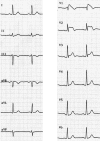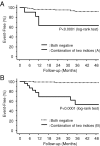Noninvasive risk stratification of subjects with a Brugada-type electrocardiogram and no history of cardiac arrest
- PMID: 16255748
- PMCID: PMC6932722
- DOI: 10.1111/j.1542-474X.2005.00055.x
Noninvasive risk stratification of subjects with a Brugada-type electrocardiogram and no history of cardiac arrest
Abstract
Background: Recent studies suggest that the Brugada-type electrocardiogram (ECG) is much more prevalent than the manifest Brugada syndrome. Although invasive electrophysiologic investigations have been proposed as a risk stratifier, their value is controversial, and alternative noninvasive techniques may be preferred. We sought a noninvasive strategy to detect a high-risk group in a long-term follow-up study of subjects with a Brugada-type ECG, and no history of cardiac arrest.
Methods: This study enrolled 124 consecutive subjects with a Brugada-type ECG. Prognostic indices included: age, sex, a family history of sudden death, syncopal episodes, a spontaneous coved-type ST-segment elevation, maximal magnitude of ST-segment elevation, a spontaneous change in ST segment, a mean QRS duration, maximal QT interval, QT dispersion, late potentials (LP) by signal-averaged ECG, and microvolt T-wave alternans.
Results: Of the 124 subjects, 20 consenting subjects had an implantable defibrillator before follow-up. During a 40 +/- 19-month follow-up, 12 subjects (9.7%) reached one of the endpoints (sudden death or ventricular tachyarrhythmia). Of the 12 risk indices, a family history of sudden death, syncopal episodes, a spontaneous coved-type ST-segment elevation, a spontaneous change in ST segment, and LP had significant values. In multivariate analysis, a spontaneous change in ST segment had the most significance (a relative hazard, 9.2; P = 0.036). Combined assessment of this index and other significant indices obtained higher positive predictive values (43-71%).
Conclusions: A spontaneous change in ST segment is associated with the highest risk for subsequent events in subjects with a Brugada-type ECG. The presence of syncopal episodes, a history of familial sudden death, and/or LP may increase its value.
Figures




Similar articles
-
Brugada syndrome: current clinical aspects and risk stratification.Ann Noninvasive Electrocardiol. 2002 Jul;7(3):251-62. doi: 10.1111/j.1542-474x.2002.tb00172.x. Ann Noninvasive Electrocardiol. 2002. PMID: 12167188 Free PMC article. Review.
-
Assessment of noninvasive markers in identifying patients at risk in the Brugada syndrome: insight into risk stratification.J Am Coll Cardiol. 2001 May;37(6):1628-34. doi: 10.1016/s0735-1097(01)01197-4. J Am Coll Cardiol. 2001. PMID: 11345376
-
[Doubts of the cardiologist regarding an electrocardiogram presenting QRS V1-V2 complexes with positive terminal wave and ST segment elevation. Consensus Conference promoted by the Italian Cardiology Society].G Ital Cardiol (Rome). 2010 Nov;11(11 Suppl 2):3S-22S. G Ital Cardiol (Rome). 2010. PMID: 21361048 Italian.
-
Relationship between ST-segment morphology and conduction disturbances detected by signal-averaged electrocardiography in Brugada syndrome.Ann Noninvasive Electrocardiol. 2003 Jan;8(1):30-6. doi: 10.1046/j.1542-474x.2003.08106.x. Ann Noninvasive Electrocardiol. 2003. PMID: 12848811 Free PMC article.
-
The prevalence, incidence and prognostic value of the Brugada-type electrocardiogram: a population-based study of four decades.J Am Coll Cardiol. 2001 Sep;38(3):765-70. doi: 10.1016/s0735-1097(01)01421-8. J Am Coll Cardiol. 2001. PMID: 11527630
Cited by
-
Sleep-disordered breathing in patients with the Brugada syndrome.Am J Cardiol. 2011 Mar 1;107(5):709-13. doi: 10.1016/j.amjcard.2010.10.046. Epub 2011 Jan 19. Am J Cardiol. 2011. PMID: 21247540 Free PMC article.
-
J-Wave syndromes expert consensus conference report: Emerging concepts and gaps in knowledge.J Arrhythm. 2016 Oct;32(5):315-339. doi: 10.1016/j.joa.2016.07.002. Epub 2016 Aug 21. J Arrhythm. 2016. PMID: 27761155 Free PMC article. No abstract available.
-
Brugada syndrome.Pacing Clin Electrophysiol. 2006 Oct;29(10):1130-59. doi: 10.1111/j.1540-8159.2006.00507.x. Pacing Clin Electrophysiol. 2006. PMID: 17038146 Free PMC article. Review.
-
J wave syndromes: molecular and cellular mechanisms.J Electrocardiol. 2013 Nov-Dec;46(6):510-8. doi: 10.1016/j.jelectrocard.2013.08.006. Epub 2013 Sep 6. J Electrocardiol. 2013. PMID: 24011992 Free PMC article. Review.
-
Diagnostic and genetic aspects of the Brugada and other inherited arrhythmias syndromes.J Electrocardiol. 2007 Jan;40(1 SUPPLIMENT):S11-S14. doi: 10.1016/j.jelectrocard.2006.10.019. J Electrocardiol. 2007. PMID: 18509512 Free PMC article.
References
-
- Brugada P, Brugada J. Right bundle branch block, persistent ST segment elevation and sudden cardiac death: A distinct clinical and electrocardiographic syndrome. A multicenter report. J Am Coll Cardiol 1992;20: 1391–1396. - PubMed
-
- Hermida J‐S, Lemoine J‐L, Aoun FB, et al Prevalence of the Brugada syndrome in an apparently healthy population. Am J Cardiol 2000;86: 91–94. - PubMed
-
- Miyasaka Y, Tsuji H, Yamada K, et al Prevalence and mortality of the Brugada‐type electrocardiogram in one city in Japan. J Am Coll Cardiol 2001;38: 771–774. - PubMed
Publication types
MeSH terms
LinkOut - more resources
Full Text Sources

